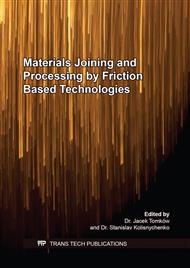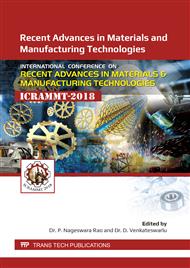p.565
p.570
p.576
p.582
p.589
p.595
p.601
p.607
p.613
Optimization of Process Parameters for Improved Corrosion Resistance and Microstructural Exploration in Friction Stir Welding of AA2024 - AA6061
Abstract:
The aluminium alloys AA2024 and AA6061 are widely used for fabricating light weight structural member with better strength and corrosion resistance. Friction stir welding (FSW) parameters such as rotational speed, tool shoulder profile and traverse speed are used to identify the corrosion resistance and microstructural analysis in different weld region of AA2024-AA6061 dissimilar joints. In this work, Taguchi L9 orthogonal array with three variables and three stages has been used to reduce the number of experiments. Potentiodynamic polarization (PDP) testing results are optimized by ANOVA technique and obtain the corrosion rate as 5.72 mil/yr and resistance polarization as 835.28 ohm.cm2. The optimal parameter set is found to be 1000 rpm, flat shoulder and 45 mm/min. The microstructural analysis reveals localized pit dissolution in the nugget zoneThe aluminium alloys AA2024 and AA6061 are widely used for fabricating light weight structural member with better strength and corrosion resistance. Friction stir welding (FSW) parameters such as rotational speed, tool shoulder profile and traverse speed are used to identify the corrosion resistance and microstructural analysis in different weld region of AA2024-AA6061 dissimilar joints. In this work, Taguchi L9 orthogonal array with three variables and three stages has been used to reduce the number of experiments. Potentiodynamic polarization (PDP) testing results are optimized by ANOVA technique and obtain the corrosion rate as 5.72 mil/yr and resistance polarization as 835.28 ohm.cm2. The optimal parameter set is found to be 1000 rpm, flat shoulder and 45 mm/min. The microstructural analysis reveals localized pit dissolution in the nugget zone.
Info:
Periodical:
Pages:
589-594
Citation:
Online since:
August 2019
Authors:
Keywords:
Price:
Сopyright:
© 2019 Trans Tech Publications Ltd. All Rights Reserved
Share:
Citation:



